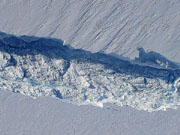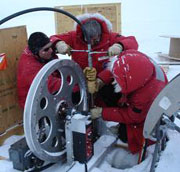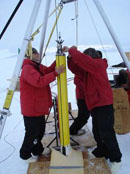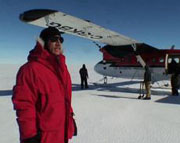VOA标准英语2011--Scientists to Drill Huge Hole in Antarctic Ice(在线收听)
Scientists to Drill Huge Hole in Antarctic Ice
Antarctica is the largest reservoir of glacial ice on the planet. An expedition of international scientists is headed to the frozen continent to study why its glaciers are retreating so fast.
What they find could help predict Antarctica’s anticipated big melt more accurately, a consequence of climate change that will significantly raise global sea levels over the coming century.
The focus is Pine Island Glacier, a mass of ice 2,300 square kilometers across and 500 meters deep. Melting in this region of western Antarctica is responsible for seven percent of the recorded sea level rise over the past few years.
 |
| A massive crack running about 29 kilometers across Pine Island glacier’s floating tongue, taken during flight over region late October 2011. |
Team leader and U.S. Space Agency glaciologist Robert Bindschadler says, “This is where Antarctica is hemorrhaging ice and raising sea level.” Pine Island Glacier is melting most rapidly underneath its ice shelf that sticks out into the ocean, Bindschadler says. “And we’re anticipating melt rates of, in some places, of over 100 meters per year, which are just phenomenally high.”
Bindschadler says the melt is triggered by the interaction of wind, water and ice, with heat rising from a cavity beneath the ice sheet. He says while satellites can map the glacier and chart its movement, they cannot measure what is going on under the ice shelf and in the cavity.
“The details of this we do not know. That’s what our measurements are going to tell us,” he says.
 |
| Near U.S. Antarctic McMurdo station scientists practice lowering the ocean profiler down a hole into the ocean beneath the ice. |
To gather data on water circulation, currents and ice flow in the ocean cavity, the team must first drill a hole in the ice. Naval Postgraduate School oceanographer Timothy Stanton says given the extreme conditions that prevail in Antarctica, the drilling is done with lo-tech simplicity.
“Basically this system makes a 27-centimeter-diameter hole through this 500-meter-thick ice shelf, using pumped hot water. In a sense it’s very primitive. It’s a very labor intensive, simple system because we had to be light and portable to get this far into the deep field.”
After the drill hits water, the scientists will send a camera down to observe the underbelly of the ice shelf and the seabed below it. Stanton says the team will also deploy a profiler, a device that moves up and down on a tight cable and can measure temperature, salinity and currents from below the ice to just above the sea floor.
 |
| A field test of the drilling system near McMurdo station during the 2010-11 Antarctic field season. |
“Then using precision depth sensors and an altimeter we can infer directly the local melt rates of the ice sheet above us. This warming is hypothesized to change the strength of the ice shelf and is very important for modeling the actual glacial properties of the ice shelf over time.”
A similar instrument array fixed to a pole will be attached to the underside of the ice shelf in a second hole. The team will determine the shape of the ocean cavity with sonar equipment. They plan to set off small explosions and bang on the ice with instruments like sledgehammers, and follow the sound waves as they echo back through the ice, water column and bed rock.
Pine Island Glacier is located 2,200 kilometers from the nearest neighbor at the U.S. McMurdo research station. The station will be powered by wind generators, solar panels, and a bank of lithium batteries that Stanton says will allow his research colleagues back at the Naval Postgraduate School in San Diego, California to maintain communications with the expedition. “And every day can modify the sampling strategy.”
 |
| In 2008, expedition leader Robert Bindschadler was the first to set foot on the Pine Island Glacier ice shelf. |
The expedition is funded by the National Science Foundation and the U.S. space agency, NASA. Oceanographer Stanton says the findings can help improve the accuracy of climate models for predicting ice sheet melt and sea level rise in the most rapidly changing environment on the planet.